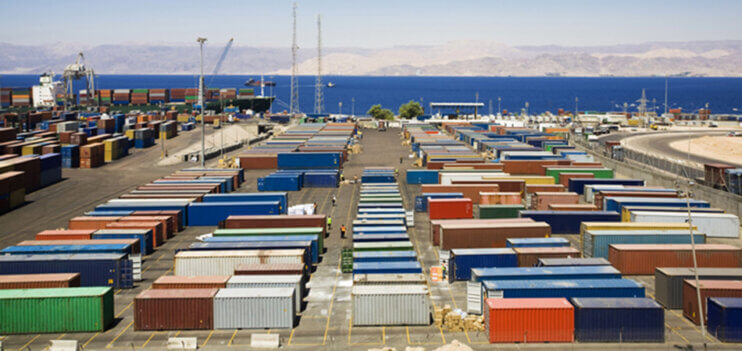US tariffs background
The US has announced increased import tariffs by country. This has been followed by much commentary about the likely effects on world trade. However, little has been said or written that provides a background to the announcement.
This blogpost summarises background information taken from the newsletter Thoughts from the Frontline, by the conservative American financial analyst John Mauldin. The information is needed by supply chain professionals when providing their input to decisions by management about implications for their organisation’s supply chains.
US international trade is different
Most sovereign countries issue their own currencies and they must roughly balance trade flows or their currency will devalue. This will reduce the buying power of citizens and creates inflation. However, America is different for one reason.
Since 1944, the US dollar has been the ‘reserve currency’ for use by the world. Central banks hold US dollars in reserve for emergencies and the majority of international commercial transactions are settled in US dollars. As a result, the non-US world needs a lot of US dollars to provide the grease that keeps the global economy operating.
To meet world demand, the US must constantly export dollars. This makes the US dollar stronger, with imports cheaper and exports more expensive – called an ‘exorbitant privilege’. But the downside is that Americans have an incentive to save less money and spend more of it (often borrowed) on imported goods.
So, trade policy and currency values are closely linked. Instead of a trade deficit, suppose the US had a trade surplus. The rest of the world would be starved of US dollars and international trade would slow. But that would also affect the US, as the dollar would strengthen enough to make US exports unaffordable to others – not good for American manufacturers or their workers. And if this persisted, eventually the reserve currency role would be adopted by another currency.
So, the monetary policy that keeps international trade flowing makes the US a permanent debtor. But if the US wants the dollar to remain the world’s reserve currency, it is required to have a trade deficit – it is not a zero-sum game.
The US consumer and prices
Recent measures of financial behaviour indicate that US consumers are likely to resist paying higher retail prices caused by increased import tariffs. Importantly, it is reported that by the end of 2025, nearly half of America’s workforce will be ‘Freelancers’ – that is 90 million people working for low pay and conditions as contractors, ‘gig’ workers and casuals. This helps to explain why credit growth is negative; nearly 11 percent of borrowers are paying the minimum repayment on credit cards; there is a record rejection rate for auto loans and mortgage refinance and people who are mainly in middle management and executive roles must again make student loan payments, which affects their spending ability.
For businesses in the US, the current signs (before the effects of tariffs) are also not good. Retail closures in the US for 2025 are expected to be double that of 2024; bankruptcies of companies with liabilities in excess of $50 million is expected to double in 2025.
Internationally, the Shanghai shipping container rate had a 10 month low and could fall further on the tariff news; and both the Baltic and Capesize Indices are near their lowest levels.
But, if higher costs from tariffs cannot be passed through to consumers as price increases, there must be a reduction in business margins. The higher the margin compression, the more that business investment and labour headcount will be reduced, which leads to a recession.
Supply Chains could be affected
The US tariff increases affect every country except Russia and the formula is simplistic. Take the US goods trade deficit with a country (the surplus in services exports is not considered), divide it by that country’s exports to the US and answer as a percentage figure. Cut that figure in half to produce the US ‘reciprocal’ tariff, with a minimum of 10 percent.
Companies in the US that are reliant on imported intermediate goods and products will need to reconsider their supply chain relationships, such as:
- Technology businesses, including semiconductor companies: they are reliant on supply chains and final assembly in Asian countries, but as they have pricing power, will maintain their margins
- Automotive: US domestic vehicle assemblers (including electric vehicles) have the potential for decreased demand if the companies do not absorb the increased costs
- Consumer Staples including packaged food: products can be reformulated for increased domestic production, but it depends on substitutability of materials, which may cause an increase in prices
- Fresh food importers: have established supply chains in defined seasons, so increased prices for short shelf life products
- Retailers: businesses selling imported apparel and footwear will need to reappraise their business model, as the majority of imports come from countries with the highest tariffs
Game theory says that other players at the table will try to protect their own interests. China has imposed 34 percent import tariffs on all US goods and the EU will do something. Smaller and poor countries will negotiate and some will capitulate. A trade deficit with a poor country exists not because it has unfair barriers, but because its low-wage workers make a lot of stuff that Americans want to buy (like T-shirts and sporting shoes). But due to their low wages, the same workers cannot afford imported American goods.
If the tariffs are ‘permanent’ and not a negotiating ploy, they are likely to alter trade patterns, although re-tooling a factory can take months and relocating factories years. There is a possibility of companies located in Asian countries with high US tariffs re-locating to India, with its lower tariff rate, but this would not be a five minute exercise. European companies that kept facilities in the UK after Brexit could re-tool (but not quickly) for US exports. This takes advantage of the UK tariff at 10 percent, instead of the 20 percent tariff placed on the EU.
Businesses will need to negotiate (over time) alternative trading relationships that could reformat global supply chains more than the direct tariffs imply. Although supply chains network systems are complex, they are adaptive, but changes will take time and a flow-on impact on contracts with suppliers and their suppliers in third party countries.

